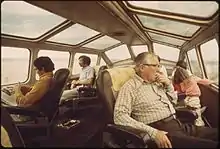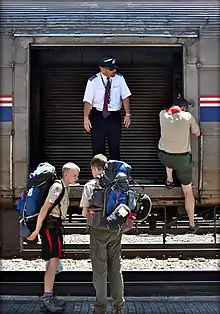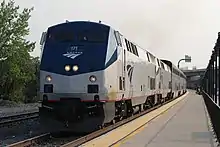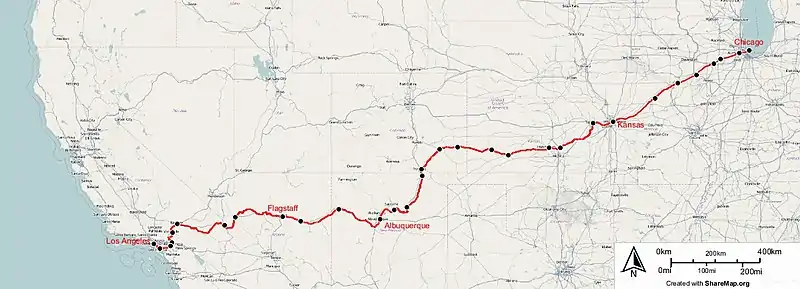Southwest Chief
The Southwest Chief (formerly the Southwest Limited and Super Chief) is a long-distance passenger train operated by Amtrak on a 2,265-mile (3,645 km) route between Chicago and Los Angeles through the Midwest and Southwest via Kansas City, Albuquerque, and Flagstaff. Amtrak bills the route as one of its most scenic, with views of the Painted Desert and the Red Cliffs of Sedona, as well as the plains of Illinois, Missouri, Kansas, and Colorado.
 Southwest Chief in February 2020. | ||||||||||||||||||||||||||||||||||||||||||||||||||||||||||||||||||||||||||||||||||||||||||||||||||||||||||||||||||||||||||||||||||||||||||||||||||||||||||||||||||||||||||||||||||||||||||||||||||||||||||||||||||||||||||||||||||||||||||||||||||||||||||||||||||||||||||||||||||||||||||||||||||||||||||||||||||||||||||||||||||||||||||||||||||||||||||||||||||||||||||||||||||||||||||||||||||||||||||||||||||||||||||||||||||||||||||||||||||||||||||||||||||||||||||||||||||||||||||||||
| Overview | ||||||||||||||||||||||||||||||||||||||||||||||||||||||||||||||||||||||||||||||||||||||||||||||||||||||||||||||||||||||||||||||||||||||||||||||||||||||||||||||||||||||||||||||||||||||||||||||||||||||||||||||||||||||||||||||||||||||||||||||||||||||||||||||||||||||||||||||||||||||||||||||||||||||||||||||||||||||||||||||||||||||||||||||||||||||||||||||||||||||||||||||||||||||||||||||||||||||||||||||||||||||||||||||||||||||||||||||||||||||||||||||||||||||||||||||||||||||||||||||
|---|---|---|---|---|---|---|---|---|---|---|---|---|---|---|---|---|---|---|---|---|---|---|---|---|---|---|---|---|---|---|---|---|---|---|---|---|---|---|---|---|---|---|---|---|---|---|---|---|---|---|---|---|---|---|---|---|---|---|---|---|---|---|---|---|---|---|---|---|---|---|---|---|---|---|---|---|---|---|---|---|---|---|---|---|---|---|---|---|---|---|---|---|---|---|---|---|---|---|---|---|---|---|---|---|---|---|---|---|---|---|---|---|---|---|---|---|---|---|---|---|---|---|---|---|---|---|---|---|---|---|---|---|---|---|---|---|---|---|---|---|---|---|---|---|---|---|---|---|---|---|---|---|---|---|---|---|---|---|---|---|---|---|---|---|---|---|---|---|---|---|---|---|---|---|---|---|---|---|---|---|---|---|---|---|---|---|---|---|---|---|---|---|---|---|---|---|---|---|---|---|---|---|---|---|---|---|---|---|---|---|---|---|---|---|---|---|---|---|---|---|---|---|---|---|---|---|---|---|---|---|---|---|---|---|---|---|---|---|---|---|---|---|---|---|---|---|---|---|---|---|---|---|---|---|---|---|---|---|---|---|---|---|---|---|---|---|---|---|---|---|---|---|---|---|---|---|---|---|---|---|---|---|---|---|---|---|---|---|---|---|---|---|---|---|---|---|---|---|---|---|---|---|---|---|---|---|---|---|---|---|---|---|---|---|---|---|---|---|---|---|---|---|---|---|---|---|---|---|---|---|---|---|---|---|---|---|---|---|---|---|---|---|---|---|---|---|---|---|---|---|---|---|---|---|---|---|---|---|---|---|---|---|---|---|---|---|---|---|---|---|---|---|---|---|---|---|---|---|---|---|---|---|---|---|---|---|---|---|---|---|---|---|---|---|---|---|---|---|---|---|---|---|---|---|---|---|---|---|---|---|---|---|---|---|---|---|---|---|---|---|---|---|---|---|---|---|---|---|---|---|---|---|---|---|---|---|---|---|---|---|---|---|---|---|---|---|---|---|---|---|---|---|---|---|---|---|---|---|---|---|---|---|---|---|---|---|---|---|---|---|---|---|---|---|---|---|---|---|
| Service type | Inter-city rail, higher-speed rail | |||||||||||||||||||||||||||||||||||||||||||||||||||||||||||||||||||||||||||||||||||||||||||||||||||||||||||||||||||||||||||||||||||||||||||||||||||||||||||||||||||||||||||||||||||||||||||||||||||||||||||||||||||||||||||||||||||||||||||||||||||||||||||||||||||||||||||||||||||||||||||||||||||||||||||||||||||||||||||||||||||||||||||||||||||||||||||||||||||||||||||||||||||||||||||||||||||||||||||||||||||||||||||||||||||||||||||||||||||||||||||||||||||||||||||||||||||||||||||||
| Locale | Midwestern and Southwestern United States | |||||||||||||||||||||||||||||||||||||||||||||||||||||||||||||||||||||||||||||||||||||||||||||||||||||||||||||||||||||||||||||||||||||||||||||||||||||||||||||||||||||||||||||||||||||||||||||||||||||||||||||||||||||||||||||||||||||||||||||||||||||||||||||||||||||||||||||||||||||||||||||||||||||||||||||||||||||||||||||||||||||||||||||||||||||||||||||||||||||||||||||||||||||||||||||||||||||||||||||||||||||||||||||||||||||||||||||||||||||||||||||||||||||||||||||||||||||||||||||
| Predecessor | Super Chief, El Capitan | |||||||||||||||||||||||||||||||||||||||||||||||||||||||||||||||||||||||||||||||||||||||||||||||||||||||||||||||||||||||||||||||||||||||||||||||||||||||||||||||||||||||||||||||||||||||||||||||||||||||||||||||||||||||||||||||||||||||||||||||||||||||||||||||||||||||||||||||||||||||||||||||||||||||||||||||||||||||||||||||||||||||||||||||||||||||||||||||||||||||||||||||||||||||||||||||||||||||||||||||||||||||||||||||||||||||||||||||||||||||||||||||||||||||||||||||||||||||||||||
| First service | May 19, 1974 (as Southwest Limited) October 28, 1984 (as Southwest Chief) | |||||||||||||||||||||||||||||||||||||||||||||||||||||||||||||||||||||||||||||||||||||||||||||||||||||||||||||||||||||||||||||||||||||||||||||||||||||||||||||||||||||||||||||||||||||||||||||||||||||||||||||||||||||||||||||||||||||||||||||||||||||||||||||||||||||||||||||||||||||||||||||||||||||||||||||||||||||||||||||||||||||||||||||||||||||||||||||||||||||||||||||||||||||||||||||||||||||||||||||||||||||||||||||||||||||||||||||||||||||||||||||||||||||||||||||||||||||||||||||
| Current operator(s) | Amtrak | |||||||||||||||||||||||||||||||||||||||||||||||||||||||||||||||||||||||||||||||||||||||||||||||||||||||||||||||||||||||||||||||||||||||||||||||||||||||||||||||||||||||||||||||||||||||||||||||||||||||||||||||||||||||||||||||||||||||||||||||||||||||||||||||||||||||||||||||||||||||||||||||||||||||||||||||||||||||||||||||||||||||||||||||||||||||||||||||||||||||||||||||||||||||||||||||||||||||||||||||||||||||||||||||||||||||||||||||||||||||||||||||||||||||||||||||||||||||||||||
| Annual ridership | 223,654 (FY22) | |||||||||||||||||||||||||||||||||||||||||||||||||||||||||||||||||||||||||||||||||||||||||||||||||||||||||||||||||||||||||||||||||||||||||||||||||||||||||||||||||||||||||||||||||||||||||||||||||||||||||||||||||||||||||||||||||||||||||||||||||||||||||||||||||||||||||||||||||||||||||||||||||||||||||||||||||||||||||||||||||||||||||||||||||||||||||||||||||||||||||||||||||||||||||||||||||||||||||||||||||||||||||||||||||||||||||||||||||||||||||||||||||||||||||||||||||||||||||||||
| Route | ||||||||||||||||||||||||||||||||||||||||||||||||||||||||||||||||||||||||||||||||||||||||||||||||||||||||||||||||||||||||||||||||||||||||||||||||||||||||||||||||||||||||||||||||||||||||||||||||||||||||||||||||||||||||||||||||||||||||||||||||||||||||||||||||||||||||||||||||||||||||||||||||||||||||||||||||||||||||||||||||||||||||||||||||||||||||||||||||||||||||||||||||||||||||||||||||||||||||||||||||||||||||||||||||||||||||||||||||||||||||||||||||||||||||||||||||||||||||||||||
| Termini | Chicago, Illinois Los Angeles, California | |||||||||||||||||||||||||||||||||||||||||||||||||||||||||||||||||||||||||||||||||||||||||||||||||||||||||||||||||||||||||||||||||||||||||||||||||||||||||||||||||||||||||||||||||||||||||||||||||||||||||||||||||||||||||||||||||||||||||||||||||||||||||||||||||||||||||||||||||||||||||||||||||||||||||||||||||||||||||||||||||||||||||||||||||||||||||||||||||||||||||||||||||||||||||||||||||||||||||||||||||||||||||||||||||||||||||||||||||||||||||||||||||||||||||||||||||||||||||||||
| Stops | 31 | |||||||||||||||||||||||||||||||||||||||||||||||||||||||||||||||||||||||||||||||||||||||||||||||||||||||||||||||||||||||||||||||||||||||||||||||||||||||||||||||||||||||||||||||||||||||||||||||||||||||||||||||||||||||||||||||||||||||||||||||||||||||||||||||||||||||||||||||||||||||||||||||||||||||||||||||||||||||||||||||||||||||||||||||||||||||||||||||||||||||||||||||||||||||||||||||||||||||||||||||||||||||||||||||||||||||||||||||||||||||||||||||||||||||||||||||||||||||||||||
| Distance travelled | 2,265 miles (3,645 km) | |||||||||||||||||||||||||||||||||||||||||||||||||||||||||||||||||||||||||||||||||||||||||||||||||||||||||||||||||||||||||||||||||||||||||||||||||||||||||||||||||||||||||||||||||||||||||||||||||||||||||||||||||||||||||||||||||||||||||||||||||||||||||||||||||||||||||||||||||||||||||||||||||||||||||||||||||||||||||||||||||||||||||||||||||||||||||||||||||||||||||||||||||||||||||||||||||||||||||||||||||||||||||||||||||||||||||||||||||||||||||||||||||||||||||||||||||||||||||||||
| Average journey time | 43 hours | |||||||||||||||||||||||||||||||||||||||||||||||||||||||||||||||||||||||||||||||||||||||||||||||||||||||||||||||||||||||||||||||||||||||||||||||||||||||||||||||||||||||||||||||||||||||||||||||||||||||||||||||||||||||||||||||||||||||||||||||||||||||||||||||||||||||||||||||||||||||||||||||||||||||||||||||||||||||||||||||||||||||||||||||||||||||||||||||||||||||||||||||||||||||||||||||||||||||||||||||||||||||||||||||||||||||||||||||||||||||||||||||||||||||||||||||||||||||||||||
| Service frequency | Daily | |||||||||||||||||||||||||||||||||||||||||||||||||||||||||||||||||||||||||||||||||||||||||||||||||||||||||||||||||||||||||||||||||||||||||||||||||||||||||||||||||||||||||||||||||||||||||||||||||||||||||||||||||||||||||||||||||||||||||||||||||||||||||||||||||||||||||||||||||||||||||||||||||||||||||||||||||||||||||||||||||||||||||||||||||||||||||||||||||||||||||||||||||||||||||||||||||||||||||||||||||||||||||||||||||||||||||||||||||||||||||||||||||||||||||||||||||||||||||||||
| Train number(s) | 3 (westbound) 4 (eastbound) | |||||||||||||||||||||||||||||||||||||||||||||||||||||||||||||||||||||||||||||||||||||||||||||||||||||||||||||||||||||||||||||||||||||||||||||||||||||||||||||||||||||||||||||||||||||||||||||||||||||||||||||||||||||||||||||||||||||||||||||||||||||||||||||||||||||||||||||||||||||||||||||||||||||||||||||||||||||||||||||||||||||||||||||||||||||||||||||||||||||||||||||||||||||||||||||||||||||||||||||||||||||||||||||||||||||||||||||||||||||||||||||||||||||||||||||||||||||||||||||
| On-board services | ||||||||||||||||||||||||||||||||||||||||||||||||||||||||||||||||||||||||||||||||||||||||||||||||||||||||||||||||||||||||||||||||||||||||||||||||||||||||||||||||||||||||||||||||||||||||||||||||||||||||||||||||||||||||||||||||||||||||||||||||||||||||||||||||||||||||||||||||||||||||||||||||||||||||||||||||||||||||||||||||||||||||||||||||||||||||||||||||||||||||||||||||||||||||||||||||||||||||||||||||||||||||||||||||||||||||||||||||||||||||||||||||||||||||||||||||||||||||||||||
| Class(es) | Coach Class Sleeper Service | |||||||||||||||||||||||||||||||||||||||||||||||||||||||||||||||||||||||||||||||||||||||||||||||||||||||||||||||||||||||||||||||||||||||||||||||||||||||||||||||||||||||||||||||||||||||||||||||||||||||||||||||||||||||||||||||||||||||||||||||||||||||||||||||||||||||||||||||||||||||||||||||||||||||||||||||||||||||||||||||||||||||||||||||||||||||||||||||||||||||||||||||||||||||||||||||||||||||||||||||||||||||||||||||||||||||||||||||||||||||||||||||||||||||||||||||||||||||||||||
| Disabled access | Train lower level, all stations | |||||||||||||||||||||||||||||||||||||||||||||||||||||||||||||||||||||||||||||||||||||||||||||||||||||||||||||||||||||||||||||||||||||||||||||||||||||||||||||||||||||||||||||||||||||||||||||||||||||||||||||||||||||||||||||||||||||||||||||||||||||||||||||||||||||||||||||||||||||||||||||||||||||||||||||||||||||||||||||||||||||||||||||||||||||||||||||||||||||||||||||||||||||||||||||||||||||||||||||||||||||||||||||||||||||||||||||||||||||||||||||||||||||||||||||||||||||||||||||
| Sleeping arrangements |
| |||||||||||||||||||||||||||||||||||||||||||||||||||||||||||||||||||||||||||||||||||||||||||||||||||||||||||||||||||||||||||||||||||||||||||||||||||||||||||||||||||||||||||||||||||||||||||||||||||||||||||||||||||||||||||||||||||||||||||||||||||||||||||||||||||||||||||||||||||||||||||||||||||||||||||||||||||||||||||||||||||||||||||||||||||||||||||||||||||||||||||||||||||||||||||||||||||||||||||||||||||||||||||||||||||||||||||||||||||||||||||||||||||||||||||||||||||||||||||||
| Catering facilities | Dining car, Café | |||||||||||||||||||||||||||||||||||||||||||||||||||||||||||||||||||||||||||||||||||||||||||||||||||||||||||||||||||||||||||||||||||||||||||||||||||||||||||||||||||||||||||||||||||||||||||||||||||||||||||||||||||||||||||||||||||||||||||||||||||||||||||||||||||||||||||||||||||||||||||||||||||||||||||||||||||||||||||||||||||||||||||||||||||||||||||||||||||||||||||||||||||||||||||||||||||||||||||||||||||||||||||||||||||||||||||||||||||||||||||||||||||||||||||||||||||||||||||||
| Observation facilities | Sightseer lounge car | |||||||||||||||||||||||||||||||||||||||||||||||||||||||||||||||||||||||||||||||||||||||||||||||||||||||||||||||||||||||||||||||||||||||||||||||||||||||||||||||||||||||||||||||||||||||||||||||||||||||||||||||||||||||||||||||||||||||||||||||||||||||||||||||||||||||||||||||||||||||||||||||||||||||||||||||||||||||||||||||||||||||||||||||||||||||||||||||||||||||||||||||||||||||||||||||||||||||||||||||||||||||||||||||||||||||||||||||||||||||||||||||||||||||||||||||||||||||||||||
| Baggage facilities | Overhead racks, checked baggage available at selected stations | |||||||||||||||||||||||||||||||||||||||||||||||||||||||||||||||||||||||||||||||||||||||||||||||||||||||||||||||||||||||||||||||||||||||||||||||||||||||||||||||||||||||||||||||||||||||||||||||||||||||||||||||||||||||||||||||||||||||||||||||||||||||||||||||||||||||||||||||||||||||||||||||||||||||||||||||||||||||||||||||||||||||||||||||||||||||||||||||||||||||||||||||||||||||||||||||||||||||||||||||||||||||||||||||||||||||||||||||||||||||||||||||||||||||||||||||||||||||||||||
| Technical | ||||||||||||||||||||||||||||||||||||||||||||||||||||||||||||||||||||||||||||||||||||||||||||||||||||||||||||||||||||||||||||||||||||||||||||||||||||||||||||||||||||||||||||||||||||||||||||||||||||||||||||||||||||||||||||||||||||||||||||||||||||||||||||||||||||||||||||||||||||||||||||||||||||||||||||||||||||||||||||||||||||||||||||||||||||||||||||||||||||||||||||||||||||||||||||||||||||||||||||||||||||||||||||||||||||||||||||||||||||||||||||||||||||||||||||||||||||||||||||||
| Rolling stock | GE Genesis Superliner | |||||||||||||||||||||||||||||||||||||||||||||||||||||||||||||||||||||||||||||||||||||||||||||||||||||||||||||||||||||||||||||||||||||||||||||||||||||||||||||||||||||||||||||||||||||||||||||||||||||||||||||||||||||||||||||||||||||||||||||||||||||||||||||||||||||||||||||||||||||||||||||||||||||||||||||||||||||||||||||||||||||||||||||||||||||||||||||||||||||||||||||||||||||||||||||||||||||||||||||||||||||||||||||||||||||||||||||||||||||||||||||||||||||||||||||||||||||||||||||
| Track gauge | 4 ft 8+1⁄2 in (1,435 mm) standard gauge | |||||||||||||||||||||||||||||||||||||||||||||||||||||||||||||||||||||||||||||||||||||||||||||||||||||||||||||||||||||||||||||||||||||||||||||||||||||||||||||||||||||||||||||||||||||||||||||||||||||||||||||||||||||||||||||||||||||||||||||||||||||||||||||||||||||||||||||||||||||||||||||||||||||||||||||||||||||||||||||||||||||||||||||||||||||||||||||||||||||||||||||||||||||||||||||||||||||||||||||||||||||||||||||||||||||||||||||||||||||||||||||||||||||||||||||||||||||||||||||
| Operating speed | 55 mph (89 km/h) (avg.) 90 mph (145 km/h) (top) | |||||||||||||||||||||||||||||||||||||||||||||||||||||||||||||||||||||||||||||||||||||||||||||||||||||||||||||||||||||||||||||||||||||||||||||||||||||||||||||||||||||||||||||||||||||||||||||||||||||||||||||||||||||||||||||||||||||||||||||||||||||||||||||||||||||||||||||||||||||||||||||||||||||||||||||||||||||||||||||||||||||||||||||||||||||||||||||||||||||||||||||||||||||||||||||||||||||||||||||||||||||||||||||||||||||||||||||||||||||||||||||||||||||||||||||||||||||||||||||
| Track owner(s) | BNSF | |||||||||||||||||||||||||||||||||||||||||||||||||||||||||||||||||||||||||||||||||||||||||||||||||||||||||||||||||||||||||||||||||||||||||||||||||||||||||||||||||||||||||||||||||||||||||||||||||||||||||||||||||||||||||||||||||||||||||||||||||||||||||||||||||||||||||||||||||||||||||||||||||||||||||||||||||||||||||||||||||||||||||||||||||||||||||||||||||||||||||||||||||||||||||||||||||||||||||||||||||||||||||||||||||||||||||||||||||||||||||||||||||||||||||||||||||||||||||||||
| ||||||||||||||||||||||||||||||||||||||||||||||||||||||||||||||||||||||||||||||||||||||||||||||||||||||||||||||||||||||||||||||||||||||||||||||||||||||||||||||||||||||||||||||||||||||||||||||||||||||||||||||||||||||||||||||||||||||||||||||||||||||||||||||||||||||||||||||||||||||||||||||||||||||||||||||||||||||||||||||||||||||||||||||||||||||||||||||||||||||||||||||||||||||||||||||||||||||||||||||||||||||||||||||||||||||||||||||||||||||||||||||||||||||||||||||||||||||||||||||
During fiscal year 2019, the Southwest Chief carried 338,180 passengers, an increase of 2.1% from FY 2018.[3] The route grossed US$43,184,176 in revenue during FY 2018, a 3.8% decrease from FY 2017.[4]
History

The Southwest Chief is the successor to the Super Chief, which was inaugurated in 1936 as the flagship train of the Atchison, Topeka and Santa Fe Railway. For most of its existence, it was "all-Pullman", carrying sleeping cars only. The Santa Fe merged the Super Chief with its all-coach counterpart, the El Capitan, in 1958. The merged train was known as the Super Chief/El Capitan, but retained the train numbers used by the Super Chief, 17 westbound and 18 eastbound.
Amtrak retained the Super Chief/El Capitan after taking over passenger rail service on May 1, 1971. During summer 1972, it was complemented by the Chief, reviving the name of another notable Chicago–Los Angeles sleeper train operated by the Santa Fe. Amtrak truncated the name to Super Chief in 1973 and, on March 7, 1974, renamed it Southwest Limited after Santa Fe forced Amtrak to discontinue using the Chief brand on its former trains because of a perceived decline in quality after the Amtrak takeover. After subsequent improvements, the Santa Fe allowed Amtrak to change the name to Southwest Chief on October 28, 1984.
The western portion of the Pasadena Subdivision was converted to the Gold Line in the 1990s, requiring the Southwest Chief to be rerouted to the San Bernardino Subdivision between Los Angeles and San Bernardino. Eastbound service was rerouted on November 28, 1993, replacing the stops at Pasadena and Pomona with Fullerton. Westbound service was rerouted on January 15, 1994.[5]: 131 [6] An additional stop at Riverside was added on April 29, 2002.[7]
Between 1997 and 1998, Amtrak operated the Southwest Chief in conjunction with the Washington–Chicago Capitol Limited. The two trains used the same Superliner equipment sets and passengers traveling on both trains could remain aboard during the layover in Chicago. Originally announced in 1996, Amtrak planned to call this through service National Chief and assign it its own numbers (15/16), but the name and numbers were never used. Amtrak dropped the practice with its May 1998 timetable.[8][9][10]
Incidents
On October 2, 1979, the Southwest Limited derailed at Lawrence, Kansas. Of the 30 crew and 147 passengers on board, two were killed and 69 were injured. The cause was excessive speed on a curve. Underlying causes included the engineer's unfamiliarity with the route and speed restriction signage having been removed during track repairs.[11]
On August 9, 1997, the eastbound Southwest Chief derailed about 5 miles northeast of Kingman, Arizona, when a bridge whose undergirding had been washed out by a flash flood collapsed under the weight of the train, which was traveling close to 90 mph (145 km/h). While the lead locomotive stayed on the track, the three trailing locomotives, nine passenger cars, and seven baggage and mail cars derailed. All stayed upright. Of the 325 passengers and crew aboard, 154 were injured and none were killed.[12]
On October 16, 1999, the westbound Southwest Chief suffered a minor derailment near Ludlow, California, following the Hector Mine earthquake. All the cars stayed upright and four passengers were injured.[13]
On March 14, 2016, the Southwest Chief derailed 3 miles (4.8 km) from Cimarron, Kansas. Of 14 crew and 128 passengers, 20 were injured. Investigators determined the train derailed after the tracks were knocked out of alignment by a runaway truck from a nearby farm operation that had rolled down a hill and struck the tracks after its owners failed to secure the parking brake.[14][15]
On June 27, 2022, the eastbound Southwest Chief derailed after striking a dump truck at a level crossing near Mendon, Missouri. Of 12 crew and 275 passengers, 3 deaths and 150 injuries have been reported; the driver of the truck also died.[16][17]
Operations

The Southwest Chief runs up to 90 mph (145 km/h) along a significant portion of its route, made possible by automatic train stop systems originally installed by the Santa Fe Railway. Of Amtrak's long-distance routes, only the Texas Eagle runs faster (with a maximum speed of 100 mph (161 km/h) through much of Illinois).[18]
During the spring and summer, volunteer rangers with the Trails and Rails program from the National Park Service travel on board and provide a narrative between La Junta, Colorado and Albuquerque, New Mexico. Beginning in May 2013, Trails and Rails volunteers also boarded to provide narration between Chicago and La Plata, Missouri.
From June through August, the Southwest Chief is used by Scouts traveling to and from Philmont Scout Ranch via the Raton station. During those months, Raton station is staffed by Amtrak employees and handles checked baggage.
This route was one of five studied for possible performance improvements by Amtrak in FY 2012.[19]
Equipment
The Southwest Chief runs Superliner train sets. Trains typically consist of two P40 or P42 locomotives, a baggage car, three or four sleeper cars, a dining car, sightseer lounge and three coach cars.[20] If demand warrants, a fourth coach is added between Chicago and Kansas City. Private cars or deadhead cars also sometimes ride along.[21]
Route
In 1979, the Southwest Chief route between Kansas City and Emporia was shifted in order to maintain service to Topeka and Lawrence, which would otherwise have lost service when the Texas Chief was discontinued.
Prior to 1996, the Southwest Chief operated in Illinois between Chicago and Galesburg via the ATSF's Chillicothe Subdivision, stopping at Joliet, Streator, and Chillicothe. Following the merger of the Burlington Northern and the Santa Fe in 1996, BNSF constructed a connector track at Cameron, Illinois, which allowed freight and passenger trains to transfer between the BN Mendota Subdivision and the Chillicothe Subdivision.[22] The Chief was rerouted on the old Burlington Northern through Naperville, Princeton, and Mendota to Galesburg, a route shared with the California Zephyr, Illinois Zephyr, and Carl Sandburg.
In January 1994, the Southwest Chief was rerouted between San Bernardino and Los Angeles onto the Santa Fe Third District via Fullerton and Riverside. Previously, it served Pasadena and Pomona via the Santa Fe Pasadena Subdivision, which was closed to all through traffic following damage to a bridge over the eastbound lanes of Interstate 210 in Arcadia during the Northridge Earthquake.
There were plans to add service to Pueblo and connecting with the proposed Front Range regional rail service between Denver and Pueblo. It would have also run along former Colorado & Southern tracks through Walsenburg, reconnecting with its current alignment at Trinidad. A more recent plan is to run a section of the train to Colorado Springs, Colorado via Pueblo.[23]
In May 2022, the Missouri General Assembly approved $1 million of state funds to establish a Southwest Chief infill station in Carrollton, between the Kansas City and La Plata stations. If approved by the governor, the state funds would have to be matched by local agencies.[24][25]
Issues on midsection of route

The part of the Southwest Chief's route in western Kansas, southeastern Colorado, and northeastern New Mexico faced uncertainty throughout the 2010s.
In 2010, BNSF said that Amtrak would have to pay for all track maintenance on the portion of the Southwest Chief' route between La Junta and Lamy (Raton and Glorieta Subdivisions), because BNSF does not run any freight trains over this segment.[26] BNSF also said that they would be lowering the track class on the portion of the Southwest Chief's route between Hutchinson and La Junta from Class IV to Class III and decreasing the passenger train speed limit from 79 mph (127 km/h) to 60 mph (97 km/h).
In return, BNSF proposed rerouting the Southwest Chief from the affected sections of track to its Southern Transcon via Wichita, Amarillo, and Clovis—the same route once used by the San Francisco Chief. To avoid a reroute, Amtrak sought help from the affected states—Kansas, Colorado, and New Mexico.[27] The states eventually contributed money toward rebuilding and rehabilitating the tracks—much of it obtained from federal transportation grants—and the route was not changed.
However, this same part of the Southwest Chief's route was threatened again in 2018 when it became the focal point of a struggle to determine whether to continue Amtrak as a national network or to operate regional stand-alone networks.[28] The issue arose when Amtrak introduced new requirements for the third renewal grant and raised previously undiscussed technical issues.[29] A letter dated May 31, 2018, co-signed by 11 Senators, condemned the action and urged providing the match.[30] In an open letter, former Amtrak President and CEO Joseph H. Boardman said, "The Southwest Chief issue is the battleground whose outcome will determine the fate of American’s national interconnected rail passenger network".[28]
In June, Amtrak announced that it was considering the replacement of rail service along the Kansas portion of the Southwest Chief with Amtrak Thruway Motorcoach buses between Albuquerque and Dodge City, where train service east to Chicago would resume.[31] Senators in the affected area succeeded in offering an amendment to a funding bill. Per a press release from the office of co-sponsor Senator Jerry Moran, "This amendment would provide resources for maintenance and safety improvements along the Southwest Chief route and would compel Amtrak to fulfill its promise of matching funding for the successful TIGER IX discretionary grant ... In addition, this amendment would effectively reverse Amtrak’s decision to substitute rail service with bus service over large segments of the route through FY2019".[32]
Ridership
| Ridership | Change over previous year | Ticket Revenue | Change over previous year | |
|---|---|---|---|---|
| 2007[33] | 316,668 | - | $37,935,113 | - |
| 2008[33] | 331,143 | $41,079,865 | ||
| 2009[33] | 318,025 | $38,033,503 | ||
| 2010[34] | 342,403 | $41,604,705 | ||
| 2011[34] | 354,912 | $44,184,060 | ||
| 2012[35] | 355,316 | $44,183,540 | ||
| 2013[35] | 355,815 | $45,129,813 | ||
| 2014[36] | 352,162 | $44,631,296 | ||
| 2015[36] | 367,267 | $44,904,314 | ||
| 2016[37] | 364,748 | $43,184,176 | ||
| 2017[38] | 363,000 | - | - | |
| 2018[39] | 331,239 | - | - | |
| 2019[39] | 338,180 | - | - | |
| 2020[40] | 186,470 | - | - | |
| 2021[41] | 135,901 | - | - | |
| 2022[42] | 223,654 | - | - |
Notes
- Amtrak's Fiscal Year (FY) runs from October 1 of the prior year to September 30 of the named year.
References
- "Amtrak Fiscal Year 2022 Ridership" (PDF). Amtrak. November 29, 2022. Retrieved December 6, 2022.
- "History of Seligman, Arizona". Seligmanhistory.com. Archived from the original on December 30, 2009. Retrieved February 8, 2021.
- https://media.amtrak.com/wp-content/uploads/2019/11/FY19-Year-End-Ridership
- http://media.amtrak.com/wp-content/uploads/2015/10/Amtrak-FY16-Ridership-and-Revenue-Fact-Sheet-4_17_17-mm-edits.pdf
- Sanders, Craig (2006). Amtrak in the Heartland. Bloomington, Indiana: Indiana University Press. ISBN 978-0-253-34705-3.
- "The Last Train Out". Pasadena Star-News. January 15, 1994. p. 1 – via Newspapers.com.
- "Riverside, CA (RIV)". Great American Stations. Amtrak.
- "Amtrak National Timetable". Timetables.org. November 10, 1996. Archived from the original on July 28, 2011. Retrieved March 14, 2010.
- "Amtrak National Timetable". Timetables.org. May 11, 1997. Archived from the original on July 28, 2011. Retrieved March 14, 2010.
- "Amtrak National Timetable". Timetables.org. May 17, 1998. Archived from the original on July 28, 2011. Retrieved March 14, 2010.
- "Derailment of Amtrak train No. 4 The Southwest Limited on the Atchison, Topeka and Santa Fe Railway Company Lawrence, Kansas October 2, 1979" (PDF). National Transportation Safety Board. April 29, 1980. Archived (PDF) from the original on February 17, 2017. Retrieved March 15, 2016.
- Riccardi, Nicholas; Gorman, Tom (August 10, 1997). "Train From L.A. Derails in Arizona; 154 Injured". Los Angeles Times. ISSN 0458-3035. Archived from the original on November 22, 2016. Retrieved November 22, 2016.
- Dvorak, John (February 4, 2014). Earthquake Storms: An Unauthorized Biography of the San Andreas Fault. New York: Open Road Media. p. 264. ISBN 978-1-4804-4786-8. Archived from the original on November 22, 2016.
- "Amtrak train derails in Kansas". BBC News. March 14, 2016. Archived from the original on March 15, 2016. Retrieved March 14, 2016.
- ""Amtrak train derails near Cimarron". Dodge City Daily Globe. March 14, 2016. Archived from the original on March 15, 2016. Retrieved March 15, 2016.
- Shapiro, Emily (June 27, 2022). "Amtrak train with 243 passengers on board derails in Missouri; injuries reported". ABC7 San Francisco. Retrieved June 27, 2022.
- "NTSB: Amtrak train was below speed limit before fatal crash". AP News. June 28, 2022. Retrieved June 30, 2022.
- Johnston, Bob (May 3, 2023). "110 mph Schedules Coming for Amtrak Chicago-St. Louis Corridor". Trains. Retrieved May 6, 2023.
- "PRIIA Section 210 FY12 Performance Improvement Plan" (PDF). Amtrak. Archived from the original (PDF) on August 19, 2016. Retrieved July 7, 2016.
- "Amtrak - Southwest Chief". www.trainweb.org. Retrieved September 24, 2023.
- "On Track On Line – Superliner Sleeper Names". on-track-on-line.com. Retrieved April 12, 2021.
- "Galesburg to Streator". Donwinter.com. Archived from the original on March 3, 2016. Retrieved July 7, 2016.
- "Senators land $225k to study adding Amtrak spur in Colorado Springs". KOAA News 5 Southern Colorado. February 29, 2020. Retrieved March 3, 2020.
- Tingerthal, Tom (May 9, 2022). "Carrollton Approved For AMTRAK Stop Funding". KCHI Radio. Retrieved May 21, 2022.
- "State Rep. Peggy McGaugh and State Sen. Denny Hoskins Announce Funding for Amtrak Station in Carrollton". The Missouri Times. May 9, 2022. Retrieved May 21, 2022.
- Zimmermann, Karl (September 2, 2019). "Amtrak's Southwest Chief lives to ride the rails another day". Los Angeles Times. Retrieved September 3, 2019.
- Fred W. Frailey, "Minus its backbone, Amtrak makes a tempting target," Trains, August 2010, 18.
- Joseph A. Boardman, "Where is the public input? Where is the transparency?" Railway Age, May 10, 2018.
- Jim Souby, "Amtrak gets big boost from Congress, grant from DOT, reviews long-distance trains," ColoRail Passenger, Issue 84, 2018, 5.
- ""We write to express our deep concern... "" (PDF).
- Ben Kuebrich, "Amtrak May End Passenger Rail Service In West Kansas. Moran: 'Amtrak Is Not Doing Its Job'", KCUR
- Senate Approves Moran, Udall Amendment to Maintain Southwest Chief Train Services Senator Jerry Moran official website Aug. 1, 2018
- "Amtrak Fiscal Year 2009, Oct. 2008-Sept. 2009" (PDF). Trains Magazine. Archived from the original (PDF) on October 30, 2013. Retrieved November 8, 2020.
- "Archived copy" (PDF). Archived from the original (PDF) on November 8, 2012. Retrieved July 30, 2012.
{{cite web}}: CS1 maint: archived copy as title (link) - "AMTRAK Sets Record and Moves Nation's Economy Forward" (PDF). Archived from the original (PDF) on August 24, 2020.
- "Amtrak FY15 Ridership & Revenue" (PDF).
- "Amtrak FY16 Ridership & Revenue" (PDF). Amtrak. April 17, 2017.
- "Amtrak FY17 Ridership" (PDF).
- "Amtrak FY19 Ridership" (PDF).
- Luczak, Marybeth (November 23, 2020). "Amtrak Releases FY 2020 Data". Railway Age. New York: Simmons-Boardman Publishing Inc. Retrieved February 18, 2020.
- "Amtrak FY21 Ridership" (PDF).
- "Amtrak FY22 Ridership" (PDF).
External links
![]() Media related to Southwest Chief at Wikimedia Commons
Media related to Southwest Chief at Wikimedia Commons
